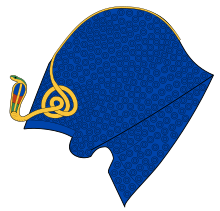Khepresh

The Khepresh was an ancient Egyptian royal headdress. It is also known as the blue crown or war crown. New Kingdom pharaohs are often shown wearing it in battle, but it was also frequently worn in ceremonies.[1] It used to be called a war crown by many, but modern historians refrain from defining it thus.[2]
The Khepresh was made from cloth[3] or leather stained blue and was covered with small yellow sun discs. Like many other royal crowns an uraeus was fastened to its front.
History
| ||
| Blue Crown "War Crown" in hieroglyphs | ||
|---|---|---|
The Blue Crown, or War Crown was represented in hieroglyphs.
The earliest known mention of the khepresh is on the stela Cairo JE 59635 [CG 20799] which dates to the reign of pharaoh Neferhotep III, during the Second Intermediate Period.[4] In this and other examples from the same era, the word is written with a determinative that represents the cap crown, a lower and less elaborate type of crown. Images of the khepresh from the reign of Ahmose I, first king of the New Kingdom and the Eighteenth Dynasty, show a headdress that is taller than the cap crown and more angular than later forms of the khepresh. This crown continued to evolve during the early Eighteenth Dynasty, attaining its best-known form in the reigns of Hatshepsut and Thutmose III.[5]
After Amenhotep III's reign – and particularly during the 18th and 19th Dynasties – it came into fashion and was even adopted by some pharaohs as a primary crown.[6] The crown ceased to be depicted in the Kushite Dynasty (747 to 656 BCE).[7]
During the New Kingdom, pharaohs were shown with this crown in military circumstances. However, some scholars think that the crown was also meant to evoke the divine power of the pharaoh, and was thereby worn to religiously situate kings as manifestations of gods on earth.[8]
Gallery
-
Pharaoh Akhenaten
-
Akhenaten and Nefertiti statuette
-
Tutankamun ushabti
-
This statue shows Amenhotep III (recarved as Ramesses II) wearing the khepresh crown.Walters Art Museum, Baltimore.
References
- ^ e.g. Myśliwiec, Karol, Eros on the Nile, Cornell University Press 2004, p.14
- ^ Kuhrt, Amélie, The Ancient Near East: C.3000-330 B.C., Taylor & Francis 1995, p.190
- ^ Maisels, Charles Keith, Early Civilizations of the Old World, Routledge 2001, p.60
- ^ Edwards, Iorwerth Eiddon Stephen; Nicholas Geoffrey Lemprière Hammond, Cyril John Gadd, The Cambridge Ancient History, Cambridge University Press 1975, p.51
- ^ Davies, W. V., " The Origin of the Blue Crown", The Journal of Egyptian Archaeology, volume 68 (1982), pp. 69–74
- ^ Bard, Katheryn A., Encyclopedia of the Archaeology of Ancient Egypt, Routledge 1999, p.412
- ^ Shaw, Ian, The Oxford History of Ancient Egypt, Oxford University Press 2003, p.348
- ^ Bryan, Betsy. "A 'New' Statue of Amenhotep III and the Meaning of the Khepresh Crown." The Archaeology and Art of Ancient Egypt: Studies in Honor of David O'Connor, ed. Z. Hawass and J. Richards. Cairo, 2007, p. 156-8.





